Evaluation of Soil and Water Conservation Function in Dingxi City, Upper Yellow River Basin
Abstract
:1. Introduction
2. Materials and Methods
2.1. Study Areas
2.2. Data Sources
2.3. Methods
2.3.1. Establishment of the Soil Conservation Evaluation Index System
2.3.2. Establishment of the Water Conservation Evaluation Index System
3. Results and Discussions
3.1. Soil Conservation Function Evaluation
3.2. Water Conservation Function Evaluation
3.3. Distribution Characteristics of Ecological Protection Important Functional Areas for Soil Conservation and Water Conservations
3.3.1. Spatial Distribution of Functional Areas and Its Relationship with Precipitation
3.3.2. Spatial Coupling between Ecological Protection Functional Areas and Cultivated Land
4. Conclusions
Funding
Data Availability Statement
Acknowledgments
Conflicts of Interest
References
- Zhao, Y.; Wang, Z.; Sun, B.; Zhang, C.; Ji, Q.; Feng, L.; Shi, M. A study on scheme of soil and water conservation regionalization in China. J. Geog. Sci. 2013, 23, 721–734. [Google Scholar] [CrossRef]
- Zhao, W.; Liu, Y.; Daryanto, S.; Fu, B.; Wang, S.; Liu, Y. Metacoupling supply and demand for soil conservation service. Curr. Opin. Environ. Sustain. 2018, 33, 136–141. [Google Scholar] [CrossRef]
- Sun, W.; Shao, Q.; Liu, J.; Zhai, J. Assessing the effects of land use and topography on soil erosion on the Loess Plateau in China. Catena 2014, 121, 151–163. [Google Scholar] [CrossRef]
- Bai, Y.; Ochuodho, T.O.; Yang, J. Impact of land use and climate change on water-related ecosystem services in Kentucky, USA. Ecol. Indic. 2019, 102, 51–64. [Google Scholar] [CrossRef]
- Hu, X.; Li, Z.; Nie, X.; Wang, D.; Huang, J.; Deng, C.; Shi, L.; Wang, L.; Ning, K. Regionalization of Soil and Water Conservation Aimed at Ecosystem Services Improvement. Sci. Rep. 2020, 10. [Google Scholar] [CrossRef] [PubMed]
- Jiang, P.; Guo, F.; Luo, Y.-C.; Wei, J.; Sun, X.-W.; Wu, G. Water and soil conservation function of typical plantation forest ecosystems in semi-arid region of Western Liaoning Province. Ying Yong Sheng Tai Xue Bao J. Appl. Ecol. 2007, 18, 2905–2909. [Google Scholar]
- Naseri, F.; Azari, M.; Dastorani, M.T. Spatial optimization of soil and water conservation practices using coupled SWAT model and evolutionary algorithm. Int. Soil Water Conserv. Res. 2021, 9, 566–577. [Google Scholar] [CrossRef]
- Su, S.; Liu, X. The Water Storage Function of Litters and Soil in Five Typical Plantations in the Northern and Southern Mountains of Lanzhou, Northwest China. Sustainability 2022, 14, 8231. [Google Scholar] [CrossRef]
- Jia, H.; Wang, X.; Sun, W.; Mu, X.; Gao, P.; Zhao, G.; Li, Z. Estimation of Soil Erosion and Evaluation of Soil and Water Conservation Benefit in Terraces under Extreme Precipitation. Water 2022, 14, 1675. [Google Scholar] [CrossRef]
- Wischmeier, W.H. Predicting rainfall erosion losses-a guide to conservation planning. Agric. Handb. 1978, 537, 285–291. [Google Scholar]
- Fu, B.J.; Liu, Y.; Lu, Y.H.; He, C.S.; Zeng, Y.; Wu, B.F. Assessing the soil erosion control service of ecosystems change in the Loess Plateau of China. Ecol. Complex. 2011, 8, 284–293. [Google Scholar] [CrossRef]
- Kulikov, M.; Schickhoff, U.; GrÖNgrÖFt, A.; Borchardt, P. Modelling soil erodibility in mountain rangelands of southern Kyrgyzstan. Pedosphere 2020, 30, 443–456. [Google Scholar] [CrossRef]
- Zheng, F.; Zhang, X.C.; Wang, J.; Flanagan, D.C. Assessing applicability of the WEPP hillslope model to steep landscapes in the northern Loess Plateau of China. Soil Tillage Res. 2020, 197, 104492. [Google Scholar] [CrossRef]
- Bhuyan, S.J.; Kalita, P.K.; Janssen, K.A.; Barnes, P.L. Soil loss predictions with three erosion simulation models. Environ. Modell. Softw. 2002, 17, 137–146. [Google Scholar] [CrossRef]
- Yao, C.; Wang, J.L.; Li, S.H.; Wang, L.X.; Ma, L.C.; Pan, J.Y.; Gao, F.; Liu, G.J. land degradation dynamic remote sensing monitoring of Fuxian Lake basin. Remote Sens. Technol. Appl. 2016, 31, 388–396. [Google Scholar]
- Hu, W.; Li, G.; Li, Z. Spatial and temporal evolution characteristics of the water conservation function and its driving factors in regional lake wetlands—Two types of homogeneous lakes as examples. Ecol. Indic. 2021, 130. [Google Scholar] [CrossRef]
- Zhou, B.Y.; Li, Z.W.; Tian, S.M.; You, Y.C. A review on water conservation capacity in Yellow River source region. Adv. Sci. Technol. Water Resour. 2002, 42, 87–93. [Google Scholar]
- Li, M.; Liang, D.; Xia, J.; Song, J.; Cheng, D.; Wu, J.; Cao, Y.; Sun, H.; Li, Q. Evaluation of water conservation function of Danjiang River Basin in Qinling Mountains, China based on InVEST model. J. Environ. Manage. 2021, 286, 112212. [Google Scholar] [CrossRef]
- Sun, W.; Shao, Q.; Liu, J. Soil erosion and its response to the changes of precipitation and vegetation cover on the Loess Plateau. J. Geog. Sci. 2013, 23, 1091–1106. [Google Scholar] [CrossRef]
- Pessacg, N.; Flaherty, S.; Brandizi, L.; Solman, S.; Pascual, M. Getting water right: A case study in water yield modelling based on precipitation data. Sci. Total Environ. 2015, 537, 225–234. [Google Scholar] [CrossRef]
- Divinsky, I.; Becker, N.; Bar, P. Ecosystem service tradeoff between grazing intensity and other services—A case study in Karei-Deshe experimental cattle range in northern Israel. Ecosyst. Serv. 2017, 24, 16–27. [Google Scholar] [CrossRef]
- Xu, F.; Zhao, L.; Jia, Y.; Niu, C.; Liu, X.; Liu, H. Evaluation of water conservation function of Beijiang River basin in Nanling Mountains, China, based on WEP-L model. Ecol. Indic. 2022, 134. [Google Scholar] [CrossRef]
- Cong, W.; Sun, X.; Guo, H.; Shan, R. Comparison of the SWAT and InVEST models to determine hydrological ecosystem service spatial patterns, priorities and trade-offs in a complex basin. Ecol. Indic. 2020, 112. [Google Scholar] [CrossRef]
- Huang, L.; Cao, W.; Wu, D.; Gong, G.-L.; Zhao, G.-S. Assessment on the changing conditions of ecosystems in key ecological function zones in China. Chin. J. Appl. Ecol. 2015, 26, 2758–2766. [Google Scholar]
- Rao, E.; Ouyang, Z.; Yu, X.; Xiao, Y. Spatial patterns and impacts of soil conservation service in China. Geomorphology 2014, 207, 64–70. [Google Scholar] [CrossRef]
- Liu, Z.Q.; Wang, H.Y.; Tian, F.X.; Bao, Y.H.; He, X.B.; Li, H.Z.; Jia, G.D. Estimation of Service Value of Soil and Water Conservation Function in Dongzhi Tablelan, Qingyang City of Gansu Province. Bull. Soil Water Conserv. 2018, 38, 168–173. [Google Scholar]
- Pang, J.; Liu, X.; Huang, Q. A new quality evaluation system of soil and water conservation for sustainable agricultural development. Agric. Water Manag. 2020, 240. [Google Scholar] [CrossRef]
- Chen, Y.; Gong, A.; Zeng, T.; Yang, Y. Evaluation of water conservation function in the Xiongan New Area based on the comprehensive index method. PLoS ONE 2020, 15, e0238768. [Google Scholar] [CrossRef]
- Wang, X.; Li, X.; Wang, J. Urban Water Conservation Evaluation Based on Multi-grade Uncertain Comprehensive Evaluation Method. Water Resour. Manag. 2017, 32, 417–431. [Google Scholar] [CrossRef]
- Cai, Q.G.; H, J.J.; Tian, L. Cou-pling Relationship between Soil Erosion Control Paradigm and Ecology Theory. Prog. Geogr. 2007, 26, 11–20. [Google Scholar]
- Wang, D.; Li, Z.; Zeng, G.; Nie, X.; Liu, C. Evaluation of Regionalization of Soil and Water Conservation in China. Sustainability 2018, 10, 3320. [Google Scholar] [CrossRef]
- Chen, H.Y. Evaluation of the importance of soil and water conservation function with forest ecosystem in Yunxian County, Yunnan. Shaanxi For. Sci. Technol. 2022, 50, 50–55. [Google Scholar]
- Xu, X.L.; Ma, K.M.; Fu, B.J.; Liu, X.C.; Huang, Y.; Qi, J. Research review of the relationship between vegetation and soil loss. Acta Ecol. Sin. 2006, 26, 3137–3143. [Google Scholar]
- Fan, J. Post-Earthquake Restoration and Reconstruction in Ludian: Evaluation of Resources and Environment Carrying Capacity and Research on Sustainable Development; Science Press: Beijing, China, 2016. [Google Scholar]
- Leprieur, C.; Kerr, Y.H.; Mastorchio, S.; Meunier, J.C. Monitoring vegetation cover across semi-arid regions: Comparison of remote observations from various scales. Int. J. Remote Sens. 2000, 21, 281–300. [Google Scholar] [CrossRef]
- Bai, Y.; Chu, D.; Tian, L.; Feng, Y.; Zhang, Z. Assessing the importance of water conservation function in Wuhan City circle. J. Geo-Inf. Sci. 2014, 16, 233–241. [Google Scholar]
- Fu, B.P. On the calculation of the evaporation from land surface. Chin. J. Atmos. Sci. 1981, 5, 23–31. [Google Scholar]
- Gu, Z.; Xie, Y.; Gao, Y.; Ren, X.; Cheng, C.; Wang, S. Quantitative assessment of soil productivity and predicted impacts of water erosion in the black soil region of northeastern China. Sci. Total Environ. 2018, 637, 706–716. [Google Scholar] [CrossRef]
- Ouyang, W.; Wu, Y.; Hao, Z.; Zhang, Q.; Bu, Q.; Gao, X. Combined impacts of land use and soil property changes on soil erosion in a mollisol area under long-term agricultural development. Sci. Total Environ. 2018, 613, 798–809. [Google Scholar] [CrossRef]
- Grizzetti, B.; Lanzanova, D.; Liquete, C.; Reynaud, A.; Cardoso, A.C. Assessing water ecosystem services for water resource management. Environ. Sci. Policy. 2016, 61, 194–203. [Google Scholar] [CrossRef]
- Hou, J.; Fu, B.; Wang, S.; Zhu, H. Comprehensive analysis of relationship between vegetation attributes and soil erosion on hillslopes in the Loess Plateau of China. Environ. Earth Sci. 2014, 72, 1721–1731. [Google Scholar] [CrossRef]
- Li, Z.; Fang, H. Impacts of climate change on water erosion: A review. Earth Sci. Rev. 2016, 163, 94–117. [Google Scholar] [CrossRef]
- Shi, Q.; Zhang, J.C.; Zhuang, J.Y.; Gu, Z.Y.; Wu, Y.W.; Liu, X. Impact of forest vegetation change on runoff in Qianshan watershed. J. Nanchang Inst. Technol. 2014, 33, 11–15. [Google Scholar]
- Yu, Z.L.; Fu, S.C.; Wang, Z.M.; Pan, Y.Y.; Yuan, J.Q.; Yang, F.; Zhang, D.W. Water conservation capacity of different vegetation types in Liaohe River basin of Jilin province. Soil Water Conserv. China 2022, 07, 51–55. [Google Scholar]
- Lu, X.X.; Ran, L.S.; Liu, S.; Jiang, T.; Zhang, S.R.; Wang, J.J. Sediment loads response to climate change: A preliminary study of eight large Chinese rivers. Int. J. Sediment Res. 2013, 28, 1–14. [Google Scholar] [CrossRef]
- Tang, J.L.; Cheng, X.Q.; Zhu, B.; Gao, M.R.; Wang, T.; Zhang, X.F.; Zhao, P.; You, X. Rainfall and tillage impacts on soil erosion of sloping cropland with subtropical monsoon climate—A case study in hilly purple soil area, China. J. Mt. Sci. 2015, 12, 134–144. [Google Scholar] [CrossRef]
- Bangash, R.F.; Passuello, A.; Sanchez-Canales, M.; Terrado, M.; Lopez, A.; Javier Elorza, F.; Ziv, G.; Acuna, V.; Schuhmacher, M. Ecosystem services in Mediterranean river basin: Climate change impact on water provisioning and erosion control. Sci. Total Environ. 2013, 458, 246–255. [Google Scholar] [CrossRef]
- Maeda, E.E.; Pellikka, P.K.E.; Siljander, M.; Clark, B.J.F. Potential impacts of agricultural expansion and climate change on soil erosion in the Eastern Arc Mountains of Kenya. Geomorphology 2010, 123, 279–289. [Google Scholar] [CrossRef]
- Wang, X.Z.; Wu, J.Z.; Wu, P.X.; Shang, G.Z.P.; Deng, L. Spatial and temporal distribution and trade-off water conservation, soil conservation and NPP services in the ecosystems of the Loess Plateau from 2000 to 2015. J. Soil Water Conserv. 2021, 35, 114–121+128. [Google Scholar]
- Gautam, S.; Mbonimpa, E.G.; Kumar, S.; Bonta, J.V.; Lal, R. Agricultural policy environmental eXtender model simulation of climate change impacts on runoff from a small no-till watershed. J. Soil Water Conserv. 2015, 70, 101–109. [Google Scholar] [CrossRef]
- Li, T.C.; Shao, M.A.; Jia, Y.H.; Jia, X.X.; Huang, L.M. Small-scale observation on the effects of the burrowing activities of mole crickets on soil erosion and hydrologic processes. Agric. Ecosyst. Environ. 2018, 261, 136–143. [Google Scholar] [CrossRef]
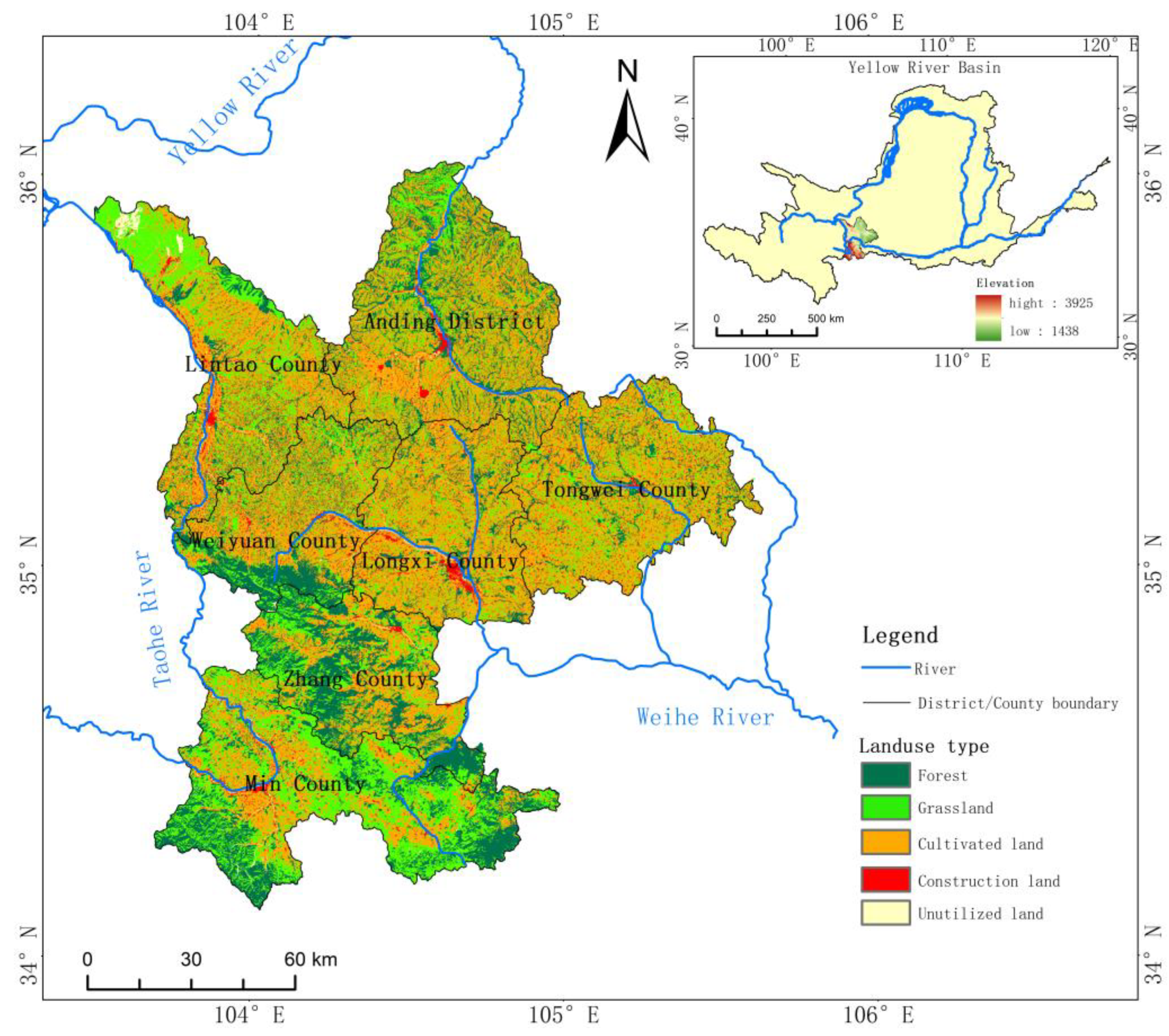
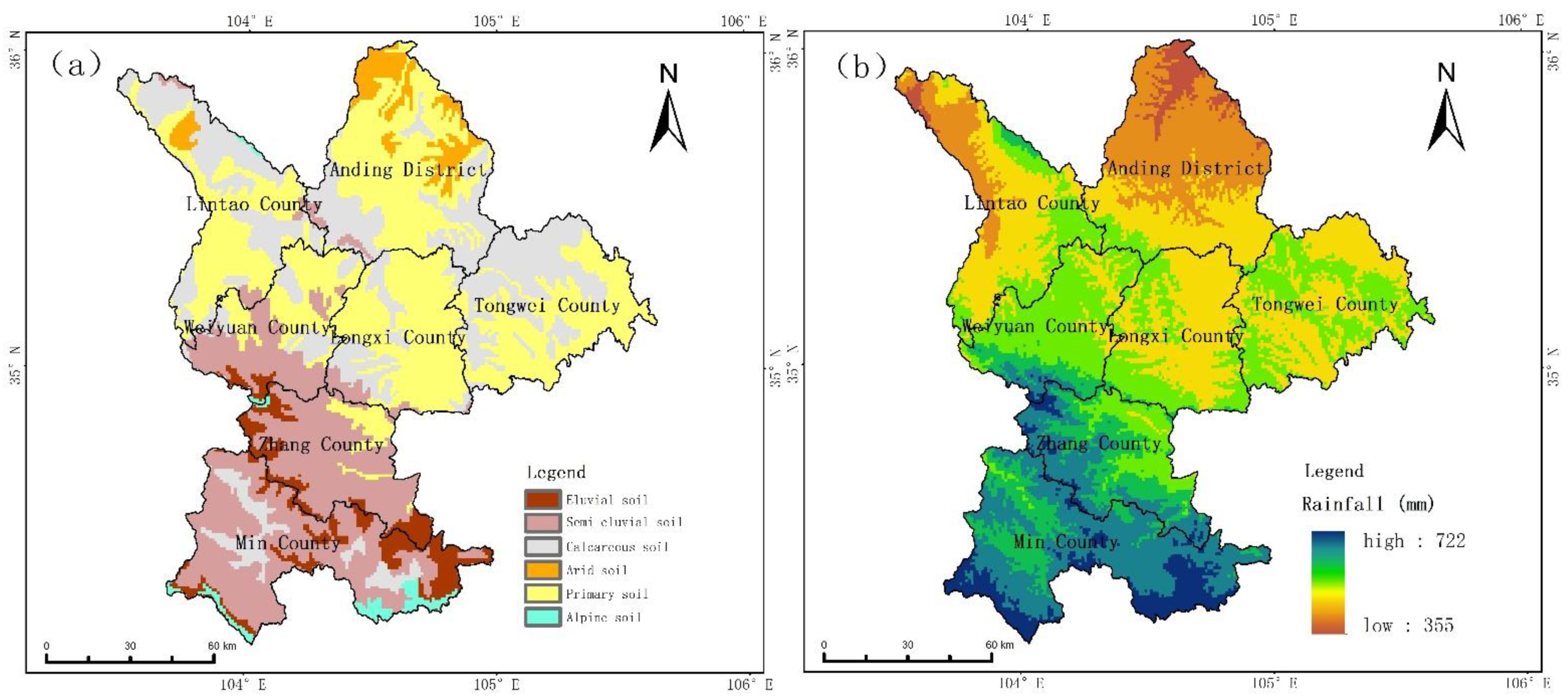
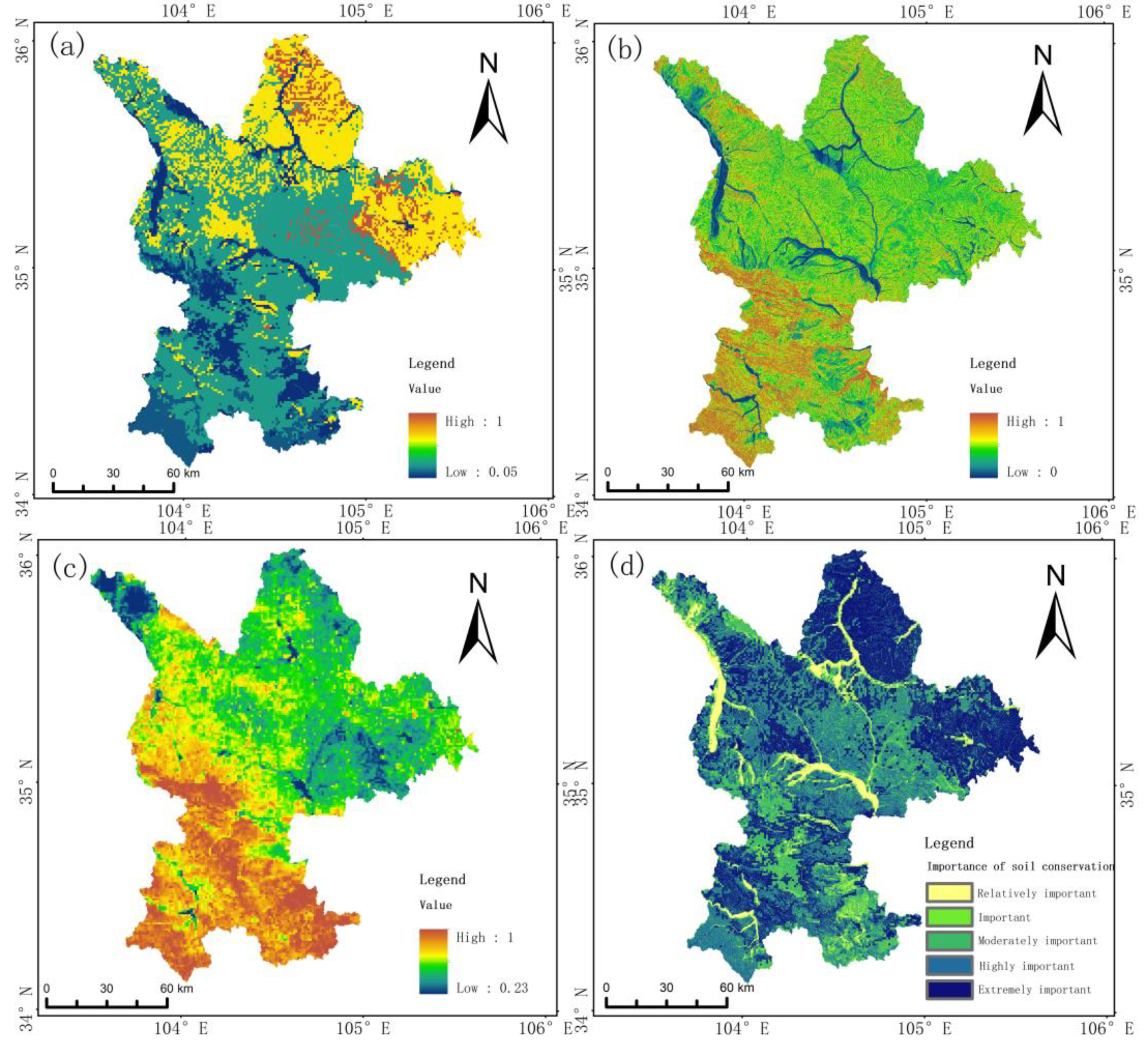

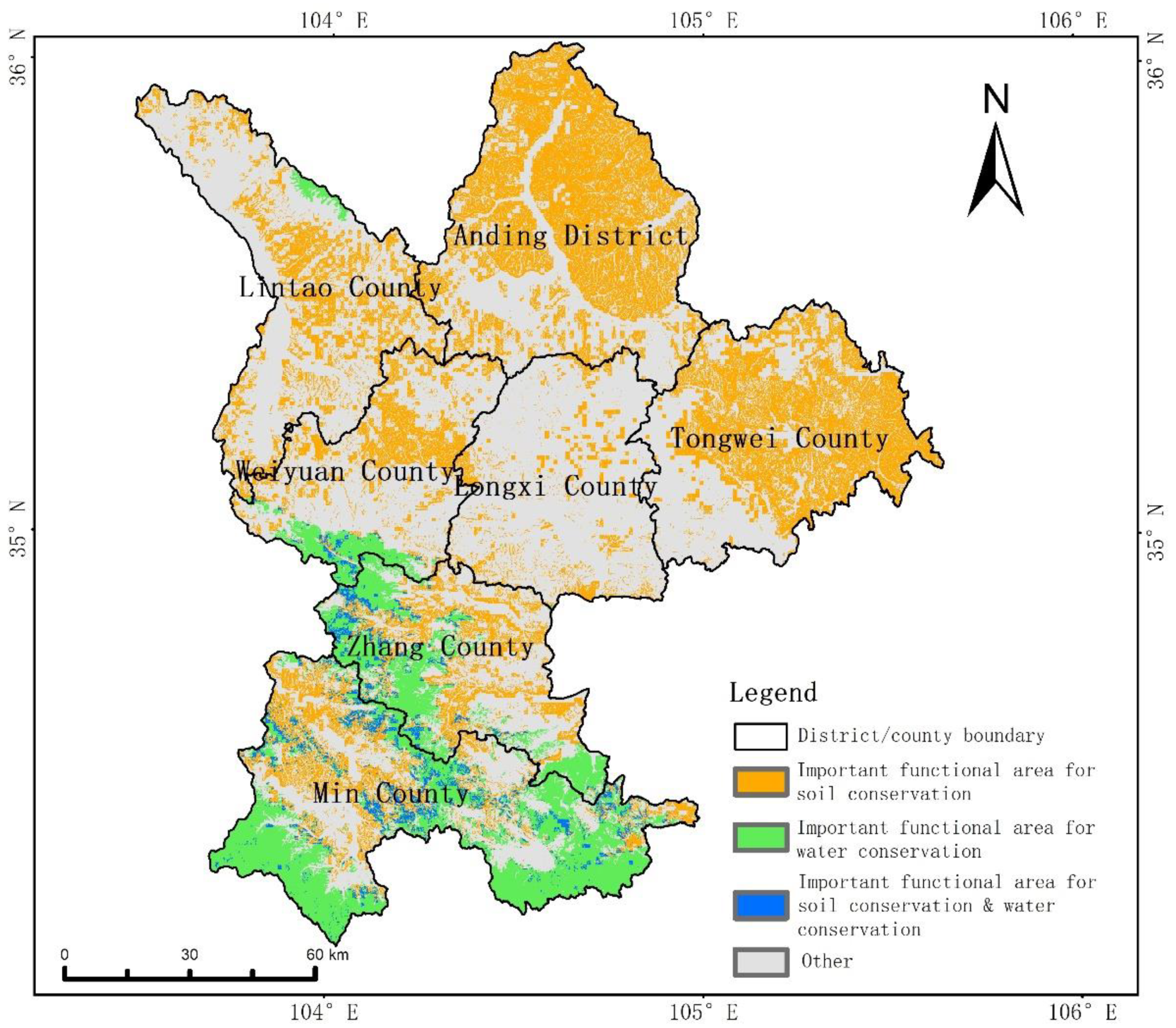
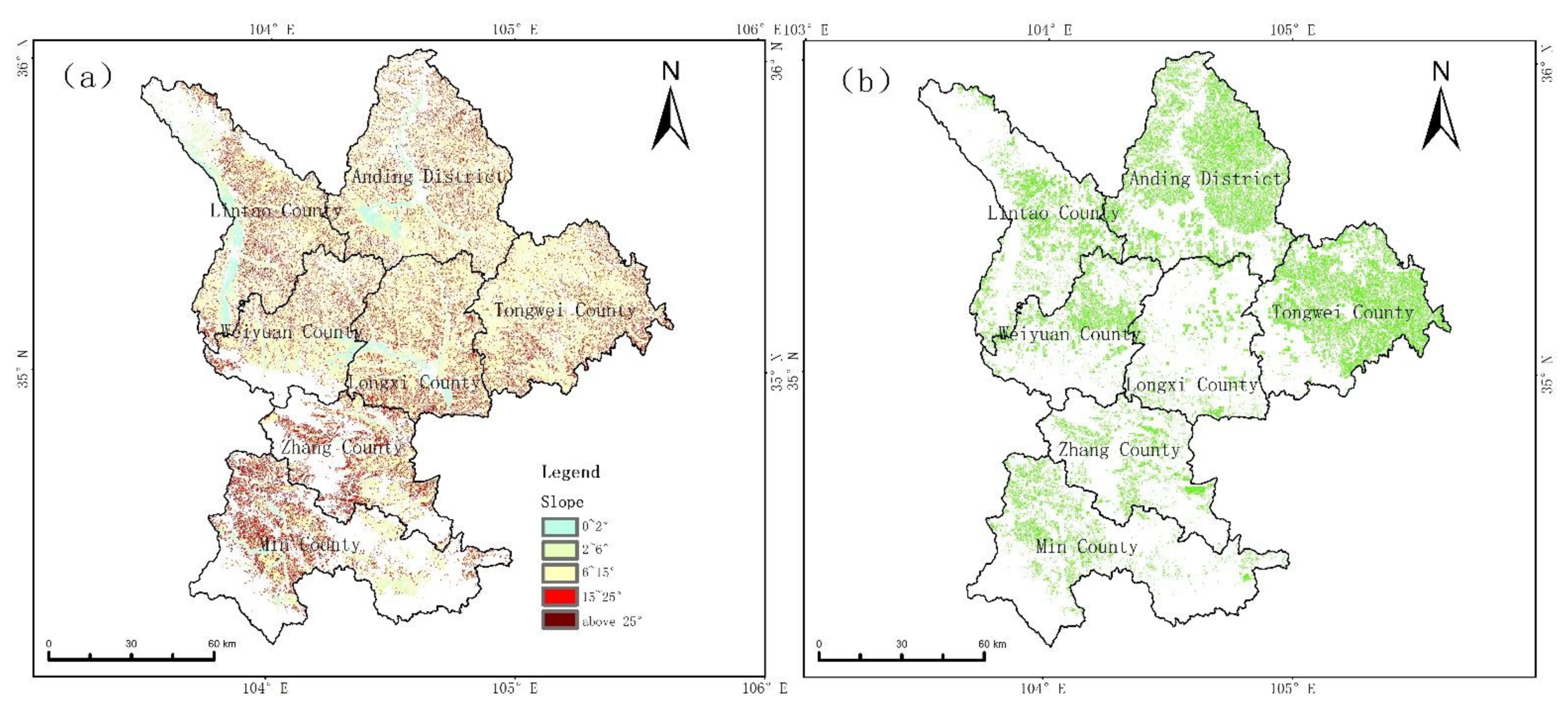

| Grading | Average Erosion Modulus (t/km2a) | Average Drain Thickness (mm/a) | Parameter Setting |
|---|---|---|---|
| 1 Micro erosion | <1000 | <0.74 | 0.05 |
| 2 Mild erosion | 1000~2500 | 0.74~1.9 | 0.1 |
| 3 Moderate erosion | 2500~5000 | 1.9~3.7 | 0.2 |
| 4 Strong erosion | 5000~8000 | 3.7~5.9 | 0.5 |
| 5 Extreme erosion | 8000~15,000 | 5.9~11.1 | 1 |
| Land Use Type | Forest | Grass, Water | Garden, Unused Land | Cultivated Land | Construction Land |
|---|---|---|---|---|---|
| assignment size | 1 | 0.8 | 0.4 | 0.2 | 0.01 |
| Precipitation | Total Area (km2) | Soil Conservation Area | Water Conservation Area | Overlapping Area | Summation | ||||
|---|---|---|---|---|---|---|---|---|---|
| km2 | % | km2 | % | km2 | % | km2 | % | ||
| <400 mm | 417.3 | 231.0 | 55.3 | 0.0 | 0.0 | 0.0 | 0.0 | 231.0 | 55.3 |
| 400–500 mm | 8581.4 | 3253.9 | 37.9 | 0.0 | 0.0 | 0.0 | 0.0 | 3253.9 | 37.9 |
| 500–600 mm | 6690.2 | 2184.3 | 32.6 | 208.3 | 3.1 | 36.2 | 0.5 | 2356.4 | 35.2 |
| 600–700 mm | 3721.9 | 781.1 | 21.0 | 2252.9 | 60.5 | 352.7 | 9.5 | 2681.3 | 72.0 |
| >700 mm | 99.4 | 3.5 | 3.5 | 98.5 | 99.1 | 3.2 | 3.3 | 98.8 | 99.3 |
| Total | 19,510.3 | 6453.8 | 33.1 | 2559.7 | 13.1 | 392.1 | 2.0 | 8621.4 | 44.2 |
| Lower | Low | Medium | High | Higher | Total | |
|---|---|---|---|---|---|---|
| 0–2° | 439.3 | 64.4 | 26.7 | 0.0 | 0.0 | 530.5 |
| 2–6° | 180.4 | 310.1 | 551.5 | 216.3 | 27.2 | 1285.4 |
| 6–15° | 51.4 | 165.5 | 1330.0 | 1967.0 | 1662.8 | 5176.7 |
| 15–25° | 0.1 | 11.3 | 105.4 | 802.4 | 1234.3 | 2153.5 |
| >25° | 0.0 | 0.1 | 13.5 | 14.9 | 152.0 | 180.4 |
| Total | 671.3 | 551.4 | 2027.1 | 3000.5 | 3076.2 | 9326.5 |
Publisher’s Note: MDPI stays neutral with regard to jurisdictional claims in published maps and institutional affiliations. |
© 2022 by the author. Licensee MDPI, Basel, Switzerland. This article is an open access article distributed under the terms and conditions of the Creative Commons Attribution (CC BY) license (https://creativecommons.org/licenses/by/4.0/).
Share and Cite
Li, J. Evaluation of Soil and Water Conservation Function in Dingxi City, Upper Yellow River Basin. Water 2022, 14, 2919. https://doi.org/10.3390/w14182919
Li J. Evaluation of Soil and Water Conservation Function in Dingxi City, Upper Yellow River Basin. Water. 2022; 14(18):2919. https://doi.org/10.3390/w14182919
Chicago/Turabian StyleLi, Jiuyi. 2022. "Evaluation of Soil and Water Conservation Function in Dingxi City, Upper Yellow River Basin" Water 14, no. 18: 2919. https://doi.org/10.3390/w14182919
APA StyleLi, J. (2022). Evaluation of Soil and Water Conservation Function in Dingxi City, Upper Yellow River Basin. Water, 14(18), 2919. https://doi.org/10.3390/w14182919







